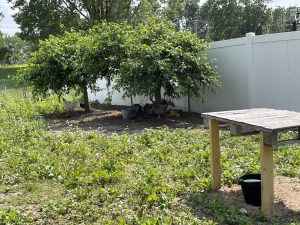Chickens love being outside. Give them a run, and they’ll lounge in the shade, scratch for tasty bugs and seeds, gobble delicious sprouts, hunker in the dust and even snatch wayward flies from the air.
How big should a run be? There’s no absolute answer. A tiny run is appreciated but the bigger it is relative to flock size the more the birds will enjoy it and the more natural food it will produce.
Chickens are constant foragers and scratchers. If many birds are crammed into a small run, they’ll soon devour every scrap of green vegetation. Expect a dusty run during dry spells, while mud reigns after rain. Even if there’s nary a bit of vegetation, hens still enjoy soaking up the sun and breathing fresh air in even the smallest run.
No run is too small, but bigger is better. A huge outdoor area of 150 square feet per hen provides room to run and fly. It also gives plants enough relief from pecking and scratching that grass can grow to produce natural chicken feed. Unfortunately, most people don’t have enough yard space to create a huge run, so the best one is as big as possible.

Fencing Chickens In
Chickens are escape artists clever enough to discover any fence gap they can squeeze through. Once free they’ll swarm across the yard, sometimes making a mess and gobbling garden crops. A good fence keeps chickens in and predators out.
Most heavy breed brown egg laying hens are weak flyers. A tight three- or four-foot-high mesh fence keeps them inside, but Leghorns, Hamburgs, and other small bodied white egg layers can launch like rockets and easily clear a low fence. They may need an eight-foot-high barrier to confine them, and sometimes they’ll even wing over it. Covering the run with wire mesh renders escape unlikely.
Hexagonal chicken wire makes an inexpensive fence but rusts quickly. Determined raccoons and dogs will tear through it. Stronger 2X4 inch wire mesh lasts longer. So does common chain link fencing. Either will foil hungry predators.
Crafting a run from wire mesh is easy. Drive metal fence posts into the ground around the perimeter about every eight feet and attach the mesh using wire twists or cable ties. Occasionally entering the run is helpful, so creating a simple gate lets humans enter while keeping chickens in.
Specially designed chicken run kits can be purchased online and at some farm stores. Fencing companies can install many types of yard fences designed for human privacy, but they also work perfectly to keep chickens in and out of sight. They can be made of vinyl, metal, or wood.
Furniture
Chickens enjoy furnishings almost as much as people. They’ll appreciate a perch or two outdoors. If the ground is hard, a dusting box filled with loose soil and diatomaceous earth helps chickens banish pesky parasites by fluffing in the dirt.
Shade and protection from aerial predators are important. Chickens usually stay beneath something when they are outdoors. Overhead structures offer cool shade underneath while frustrating overhead predators. Here are possible overhead structures:
- Shrubs pruned to spread widely.
- An old picnic table.
- A sheet of plywood suspended between two sawhorses with a weight on top to keep the wind from blowing it to the next county.
- A chicken ramada. These are easy to make and are free. Salvage a few pallets from a scrap heap. Salvage boards from one and use the wood to craft legs to suspend a pallet horizontal a few feet above the ground. See the photo.

Vegetation
The best runs are large enough to allow plants to thrive. Grass and many weeds are enthusiastically devoured by chickens, while attracting insects that add protein to a foraged chicken meal. Seeding the run with these plants makes it attractive, reduces mud, creates chicken feed, and attracts desirable bugs:
- Grass seed: Scattering annual ryegrass or any other turf grass seed works if there’s enough space. If too many chickens are crammed into a small run, they’ll gobble up the seed! Avoid chemically treated seeds.
- Buckwheat: A great run plant. Chickens won’t eat the plant but it is an insect magnet that lures these protein rich snacks to the run for the birds to snack on.
- Turnips, radishes, and kale. Deer hunters create food plots with plants designed to nourish deer. Many work perfectly in a chicken run. Food plot seed mixes can often be bought in places that sell hunting equipment or online.
- Weeds: Plant nothing and weeds appear. Many, like dandelions, lambs’ quarters, purslane and wild beets make delicious chicken chow, but they don’t like some other weeds. Prostrate vervain, motherwort, creeping Charlie and others are ignored by chickens but help keep mud at bay and attract insects.
Many commercially raised chickens spend their entire lives inside. Perhaps they dream about strolling over a grassy insect filled lawn. hey never get that chance but backyard flock owners can make chicken lives pleasant by adding an outdoor run to the coop.